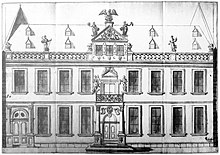Barckhausen Palace
The Barckhausensche Palais (also called Palais Barckhaus ) was a baroque palace in Frankfurt am Main .
history
The palace was built around 1711 as a city palace for the Barckhaus (en) family on the south side of the Zeil . Not far from the new Barckhausen Palace was a baroque house, which was also built for the Barckhausen-Wiesenhütten family around 1700.
The von Barckhausen patrician family, who fled to Frankfurt during the Thirty Years' War, ran international wholesale and banking businesses.
For two years, from 1742 to 1744, it served Charles VII as a residence and thus temporarily became the imperial palace. The Frankfurt senator, lawyer and later Reichshofrat Heinrich von Barckhaus (1691–1752) made his city palace available to the emperor during this time. At this time, the Zeil continued to develop into one of the most famous big city boulevards of its time.
This branch of the family died out with Heinrich von Barckhaus in 1752. He was married to Elisabeth Catharina von Barckhaus (* 1696 Frankfurt am Main as Katharina Elisabeth von Kellner, † 1749 ibid), a German citizen's wife and founder from Frankfurt am Main.
The Barckhausensche Palais, which was classically modified and extended around 1800 , had to give way shortly before 1908 for the new Wronker department store to be built .
References and comments
- ^ Barckhausen as a member of the Frankfurt patriciate
- ^ Rainer Koch, Patricia Stahl: Election and coronation in Frankfurt am Main. Kaiser Karl VII. 1742–1745 - Volume II: Exhibition catalog . Historisches Museum Frankfurt am Main, Frankfurt am Main 1986, p. 248; here it is wrongly stated that the Barckhausen Palace (old: Zeil 35 / new: Zeil 103) was only destroyed in the Second World War. Apparently the authors are confusing the Barckhausen Palace with a baroque house (old: Zeil 45 / new: 113) that was also built not far from it for the Barckhausen-Wiesenhütten family around 1700 and which actually stood until the Second World War.
